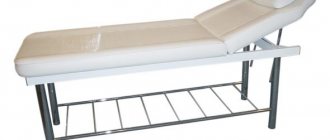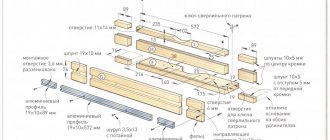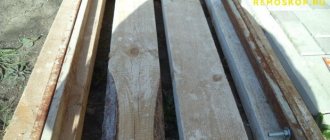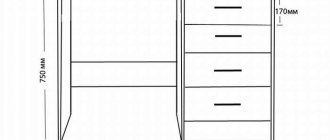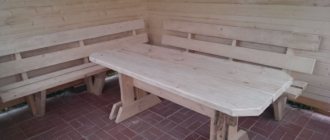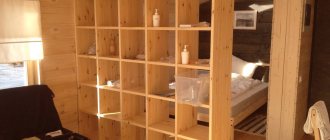Main advantages
In terms of their functional purpose, chaise lounges are the same chairs, but more stable and with a low seat. You can relax in them in a semi-lying position, which allows you to relax your spine and all muscle groups as much as possible.
The undeniable advantage of sun loungers is their comfortable shape. The garden chair can be folded in such a way that it can be used for sitting or lying down, depending on the person’s personal preferences.
Traditionally, deck chairs for summer cottages are made of wood, because since ancient times it has been considered the most environmentally friendly, economical and easy-to-use material.
Sun loungers are ideal for observing nature as they are light weight and very comfortable. Therefore, it is not surprising that many owners install them in their gardens or dachas. Such furniture can stand outside throughout the summer, and for the winter it can be put away in some suitable room, for example, a storage room.
Most often, garden beds are made from materials such as:
- tree;
- plastic;
- rattan.
If you don’t want to spend time and effort assembling a garden lounger yourself, you can always order it from a furniture showroom.
Chaise lounge functions
It is no coincidence that more and more summer residents are thinking about making a sun lounger. This device attracts them with its functional features:
- A garden lounger provides the most comfortable conditions for resting the spine and the muscles located next to it. In the reclining position, the back muscles, which are subject to particularly high loads when working in the beds, relax as much as possible.
- The sun loungers are not only easy to use, but also easy to fold, allowing you to move them from one place to another.
- Design features allow the owner to effortlessly change the backrest tilt from a sitting to a lying position.
- A wonderful decoration for a summer cottage that will look great not only in the garden, but also on the veranda. A chaise longue can give a country house a stylish and beautiful look.
- A great way to relax for people of different sizes. Due to their high reliability, such devices can easily withstand up to 100 kg of live weight.
Types of structures
If you have finally decided to start making a sun lounger for yourself, then first it won’t hurt you to get acquainted with the main types of sun loungers for your dacha. There are quite a lot of them, so only the most popular ones will be discussed below:
- Wooden sun loungers. Wood is traditionally considered one of the most environmentally friendly materials, which is completely safe for human health. Many manufacturers produce wooden sun loungers of various shapes and designs. Among them there are chairs with reclining backs, as well as full-fledged loungers that follow the curves of the human body down to the millimeter. The main disadvantages of such sun loungers are related to the material: wood has a fairly hard surface, so you won’t be able to lie on such a chair for a long time. In addition, to move such a lounger, you will have to make some effort.
- Plastic sun loungers. These garden chairs are no less popular than their wooden counterparts. After all, they have much less weight, which means that moving them to another place will not be difficult. In addition, they are not afraid of moisture, do not require special care and are much cheaper than beds made of natural wood.
- Sun loungers made from pallets. Sometimes in stores you can find an unusual version of deck chairs for summer cottages, made from pallets, which are commonly called stands used for moving various loads. Pallets are usually made from boards. But you don’t have to spend money on buying such a chair. If you have used pallets in mind, then you can make a comfortable lounge chair out of them yourself.
- Fabric sun loungers. These sun loungers are very easy to store and move. The main element of their design is a folding wooden or metal frame into which the seat is sewn. The only drawback of such a lounge chair is that the fabric is very short-lived.
These are just some of the sun loungers that you can purchase for your summer cottage. If you wish, you can make your own chaise lounge in the form of a swing, and also using ordinary tree branches as material. It all depends on your preferences.
Making a wooden sun lounger
First, you need to prepare a certain set of materials and tools that you will need to make a homemade sun lounger:
- self-tapping screws;
- jigsaw and screwdriver;
- boards for covering the frame, 2.5 cm wide;
- timber 40x40 mm for the frame;
- corners for fastening boards (4 pcs.); wooden slabs 20 mm thick.
When going to the store to buy boards and slabs, we advise you to choose material made from softwood. It withstands the negative effects of precipitation much better and has a wonderful aroma.
Stages of work
Now that you have everything you need prepared, you can proceed to assembling the wooden lounger.
First you should decide on the size of the garden chair. You can use a ready-made drawing or create it yourself. Typically standard sun loungers measure 60 x 200 cm.
Now you can start making the frame. For it you will need bars, from which you need to make four sidewalls - two of them should be 200 cm long, and two more should be 60 cm long. The finished sidewalls must be subsequently connected to each other using fastening corners.
On the outside, the frame must be sheathed with a board 2.5 cm wide.
We take the long sidewalls and attach 4 legs to them, having first stepped back 8 cm from the edge. The legs can be made from beams 10 cm long. We use self-tapping screws to attach them to the frame.
Having finished making the frame, we begin to assemble the lattice. For it we need wooden slabs, from which we need to cut boards measuring 60 x 10 cm using a jigsaw.
We attach the boards to the chaise lounge frame using self-tapping screws. Be sure to leave a gap of about 1.5 cm between the boards. Then the lattice of the sun lounger will look neat and beautiful.
If desired, you can make a chaise lounge with an adjustable back. In this case, the lattice must be divided into two parts. One of them will serve as a lounger, and the other as a headboard. We mount both parts to the connecting boards. To securely connect elements, it is best to use door hinges.
So that the headboard can be fixed in a certain position, a transverse bar should be added to the frame structure on the inside. You need to attach a support post for the headboard to it using self-tapping screws. If you don’t have one, you can buy it at any hardware store.
Now that your homemade summer cottage is ready, all that remains is to sand the boards, cover them with drying oil or a special paint and varnish material to protect them from moisture.
Making a fabric lounger
If for some reason a wooden folding lounge chair is not suitable for you, then you can try making a fabric lounge chair instead.
Materials and tools
To make a chaise lounge from fabric material you will need the following:
- bolts with nuts 8 mm;
- a piece of durable fabric 200x60 cm;
- round slats 2 cm thick (one strip 700 mm long, two 650 and two 550 mm);
- rectangular boards 30x60 cm thick (two boards 1200 mm long, two 1000 mm long and two 600 mm long);
- sandpaper.
To make a frame lounger, it is best to use tarpaulin, camouflage or denim fabric. They have sufficient strength and are resistant to wear.
Algorithm of actions
Now you can proceed directly to assembling the fabric lounger.
- To make your garden lounger mobile and easy to fold, you need to take pre-cut slats and assemble three frames from them. Frame A should have dimensions of 120 X 65 cm, frame B - 100 x 60 cm and frame C - 70 X 60 cm. Small holes need to be made on the longitudinal slats, measuring 75 and 45 cm from their beginning. In frame B, 2-4 cutouts are made at intervals of 6-10 cm so that you can change the angle of the sun lounger.
- To complete the assembly of the sunbed, frames A and B need to be connected to each other using screws, and then inserted into pre-made holes on the slats. Frames A and B are connected using the same scheme.
- Having finished with the frame, you can move on to making a seat for the future chaise lounge. To calculate the dimensions of the material, simply attach the prepared piece of fabric to the lounger in the folded position. Make sure the fabric is taut in all places, but not too tight.
- After making the pattern, its edges need to be processed and hemmed. This will increase the wear resistance of the material.
- Now the fabric needs to be fixed to the round slats located on frames A and B. The slats are wrapped in fabric and small nails are driven into them at the fastening points. Although you can do it a little differently - make loops on the fabric and put them on the slats.
As you can see above, making a chaise lounge for a summer house from fabric is no more difficult than a similar lounge chair made from wood.
Buying a garden chair
Perhaps some summer residents will not want to spend time and money making a sun lounger with their own hands. In this case, you can go to the store and buy a ready-made garden lounger. The furniture showroom will offer you a variety of such products to choose from. Surely among them you will find both budget options and unusual designs of designer models of outdoor loungers.
After studying the proposed options and comparing their characteristics, all you have to do is decide on the amount you are willing to pay for a sun lounger. The cost of such sun loungers depends on the size and material of manufacture:
- wooden sun loungers will cost you between 6,000-15,000 rubles;
- for plastic sun loungers you will have to pay from 1500 to 9000 rubles;
- Folding frame sun loungers, which can be purchased for RUB 1,350-9,500, won’t hurt your pocket too much.
When traveling to the countryside, many are warmed by the thought that they will have the opportunity to lie in the fresh air for at least a few minutes and enjoy the surrounding nature. But everyone has the power to make their vacation more enjoyable if they prepare a place for it in advance. To do this, you must have special furniture like a chaise lounge.
The easiest way is to buy such a sun lounger at the nearest furniture store, although some owners often make their own sun loungers and thereby save a lot. You can do the same, especially since you don’t need to have special skills and knowledge to do this. Even the most ordinary wooden deck chair for a summer cottage can be made from a material that is likely to be found in any household.
But in any case, you will have to prepare for this work, because without drawings you are unlikely to be able to make exactly the chaise longue that you want, especially if you do not have the slightest experience in this matter.
A homemade chaise longue for a summer house is much preferable to a store-bought lounge chair, because you can decide for yourself how it should turn out, and upon completion of the work, decorate it at your discretion. Of course, this will require some effort on your part, but in the end all this will be compensated by the comfort that your homemade chaise lounge will provide you with.
Further care
If you carefully approach the preparation of wooden parts, then special care will not be required. But over time, all the steps of sanding, impregnation, priming and painting should be repeated by removing the fabric seat. The removable seat can be removed when it rains and can be easily washed when dirty. You can also make it from washable fabric. For the winter, it is better to put the sun lounger indoors.
The simple process of making a chaise lounge with your own hands will please any craftsman with a wonderful end result. A variety of materials and fabrics will allow you to be creative and create an original item. And with proper care, the chaise longue will serve you for many years.
DIY chaise longue
The summer season is approaching and it's time to think about creating a chaise lounge with your own hands. It will allow you to enjoy your outdoor recreation to the fullest.
Chaise longue in French means long chair. This is a chair for relaxing. It can, at the owner’s request, change the position of the backrest.
DIY chaise longue
Sun loungers are widely used on beaches and by pools. On personal plots, dachas.
Sun loungers are made from various materials:
- wood;
- plastic;
- aluminum;
- rattan;
- PVC pipes;
- durable fabric.
Wooden sun loungers are the most popular and environmentally friendly. They come in a variety of shapes and designs. The disadvantage of monolithic wooden sun loungers is their weight. But this problem can be solved with the help of wheels.
Plastic sun loungers are characterized by easy mobility, ease of maintenance, and relatively low cost. Their minus is their fragility.
Fabric loungers are versatile and comfortable. Their frame is made of wood, metal or PVC pipes. They fold easily and do not take up much space.
Rattan sun loungers look great in the lap of nature. They are environmentally friendly. However, purchasing them is expensive. If you have sufficient skills, you can simply weave a rattan lounger yourself.
In this article we will tell you how to create wooden sun loungers with your own hands.
Material selection and features
When choosing materials for making a wooden lounger with your own hands, attention is paid to:
- material capabilities;
- personal preferences of the owners;
- general style of the garden;
- availability of available materials.
The main thing when choosing wood is to pay attention to its technical capabilities, such as durability, wear resistance, resistance to sunlight and high moisture. For example, the most practical tree species are: oak, beech, larch, ash.
Monolithic chaise lounge made of wood
Solid models are heavy. Therefore, to make it easier to carry, wheels are added to the headboard. The following instructions will help you make a chaise lounge on wheels with your own hands.
You will need tools:
- electric jigsaw or hacksaw;
- drill;
- screwdriver;
- self-tapping screws;
- fine grain sandpaper;
- spirit level;
- roulette.
When choosing a tree, pay attention to coniferous species. They are sold at affordable prices and are characterized by increased water resistance. Materials needed for a sun lounger:
- glued slab made of wood, its thickness should be 2 cm or more; at least 2 cm thick.
- boards 0.25 cm thick.
- wooden beam with a square section of 50x50 mm;
- 4 wheels with a diameter of 10cm;
- corners for strengthening the bed;
- door hinges;
- varnish or paint.
We suggest you make a chaise lounge according to this pattern.
Legend:
- Front legs.
- Hind legs.
- Bearing longitudinal.
- Back support.
- Back support.
- Bearing transverse.
- Fixing bar.
- Backrest support.
- Wheels.
- End beam.
- Back slats.
- Seat slats.
- The support beam is transverse.
- Fixing bar.
You can independently determine the size of the desired sun lounger and make calculations. Or use the standard size 60x190 cm. It is the most optimal and ergonomic for the average adult.
General recommendations
To ensure the longevity of the effort expended, the materials used must be processed.
Antiseptics and special impregnations will help protect wood from moisture, harmful insects, rot, and mold. It is better to carry out processing before assembling the structure.
After installing the sunbed, the wooden parts should be coated with primer, drying oil, varnish or paint. This will extend the life of your masterpiece.
Fabrics should also be protected from rain and sun. Water-repellent impregnations will help preserve their brightness and service. Their effect lasts 2-4 weeks.
And, of course, remember the famous Russian proverb when working. Measure seven times, cut once.
Assembling a chaise lounge on wheels
We assemble the base frame from the bars. We secure the load-bearing parts with corners similar to those that secure the base of the bed.
We sheathe the resulting frame with pre-prepared and sanded boards.
We make blanks for the legs from timber. Their height usually ranges from 5-10 cm. Choose one that is comfortable for yourself and your household.
We drill holes with a drill, retreating 5-7 cm from the ends of the longitudinal sides. We secure the legs with long bolts. We control the horizontal side with a spirit level.
We screw the wheels to the center of the legs with bolts with a diameter of 30mm.
Let's start cutting the lattice elements. Use a hacksaw or jigsaw to cut 8x60cm boards.
Using self-tapping screws and a screwdriver, screw the slats to the chaise lounge frame. Since the boards are not screwed tightly, we use spacers to obtain even gaps.
We should have two parts. The smaller one is intended for the headboard. We connect both grilles with door hinges. We install a support bar under the opening part.
All that remains is to sand off the production flaws. Apply wood primer. Paint it in your favorite color and the chaise longue with your own hands is ready.
For a more comfortable stay, you can sew additional mattresses that fit the size of the bed.
Simple sun lounger
To create a wooden chaise lounge with your own hands, you need the following materials, as well as tools:
- tape measure and square;
- pencil;
- saw;
- electric drill;
- screwdriver or screwdriver;
- screws, self-tapping screws and studs for fixation;
- sandpaper or grinder;
- wood putty;
- dye.
Wooden beams used in the work:
- for the back of the chaise lounge, take boards 5×10 with a length of 88 cm - 2 pieces, 39 cm - 3 pieces, 60 cm - 1 piece;
- 2 longitudinal bars for a frame 215 cm long;
- 2 cross beams -50 cm;
- 6 legs -35 cm;
- 13 slats for a seat measuring 2.5 x 8 x 60 cm;
- 6 slats for the back - 2.5? 8? 88 cm.
The first priority is to create a very strong frame. We take two parts 215 cm long, connect them with screws to half-meter transverse parts.
Let's move on to sitting. Take all the 60 cm slats. Attach them to the frame with self-tapping screws, leaving small gaps. To ensure that the gaps are even and uniform, use spacers 1 cm thick.
We create the legs of the lounger. To give maximum stability to the chaise longue, two legs are nailed at once at the legs. One at a time at the head. The instructions indicate bars with a height of 35 cm. But you can choose a height that is comfortable for you
We make the back from 2 boards measuring 88 cm and 3 boards measuring 39 cm. The resulting frame should easily fit into the base, leaving a small gap between the structures.
We securely fasten the longitudinal strips. We round them for a more beautiful look.
Attach the backrest to the base of the lounger. To do this, you need to drill holes at a distance of 9cm from the edge of the seat. Secure with pins.
We make 2 grooves at the base of the sun lounger for the support bars. The first 5x10 cm notch should be approximately 9 cm from the stud. The second is 20cm from the first. But its depth will be only 5x5 cm.
A 60cm beam is inserted horizontally into the first recess. To change the position, the board is transferred vertically to the second recess.
Sand all rough edges and imperfections. Process it. Cover with paint or varnish. The chaise lounge is ready with your own hands.
>Video DIY garden lounger
Care of the finished product
The service life and functionality of a country lounger largely depends on proper care for it . To ensure that it brings only pleasure to the owner for many years, the following activities should be carried out regularly:
- wet cleaning of textile elements;
- lubrication of folding mechanisms;
- timely painting.
For the winter, it is recommended to put the homemade chaise lounge indoors. This will further increase its service life and will allow you to use it in the country for many more years.
Many of our compatriots who own dachas arrange their holidays there in different ways. You can often find wooden sun loungers in their areas, which provide them with excellent conditions for relaxation. For the most part, these are home-made structures that can be made with your own hands, even without experience in the construction field. Due to the simplicity of the design, sun loungers can be made from available material. But it’s still not worth starting such work without a drawing.
It is also recommended to find out in advance exactly what tools will be needed and how much material is needed, so that when making a wooden chaise longue with your own hands, you can achieve even greater savings.
Fabric chaise lounge
A chair with a frame complemented with fabric is one of the most comfortable, budget types of chaise lounges. It is convenient to fold and easy to carry. Can be stored flat. It takes up little space.
To create a sun lounger with your own hands you will need:
- bolts, nuts with a diameter of 8 cm;
- small nails with round heads;
- round sticks (1 piece -65cm, 2 pieces - 50cm, 2 pieces -60cm);
- rectangular bars 25x60cm thick (2 pieces 120cm, 100cm and 60cm long);
- needle file, fine-grain sandpaper;
- glue;
- durable material measuring 200 by 50 cm.
Choose materials carefully so that your work is not in vain. Hardwood blocks are perfect for a sun lounger. Choose:
- birch;
- oak;
- beech.
Choose fabrics with maximum strength. Great fit:
- teak for mattresses;
- tarpaulin;
- canvas;
- camouflage;
- denim
These materials have increased wear resistance and will last you a long time. Let's move on to creating a sun lounger with our own hands. The base consists of three frames:
- A.1200x600 mm.
- B.1100x550 mm.
- H.650x620 mm.
Cut the boards to the required length. We sand with sandpaper.
In the longitudinal bars we make indents of 70 and 40 cm, and drill holes with a diameter of 8 mm with a drill, just like the bolts. Sand with a round file.
We make cutouts in part B. They will allow you to change the position of the back later. To do this, retreat 7-10 centimeters. It is necessary to cut 3 or 4 recesses. We polish well.
According to the diagram, we drill holes in the bars to connect the parts.
Assembling the base of the lounger. We connect frames A and B using screws. Then we connect frames A and B. For greater reliability, we lubricate the ends of the round slats with PVA before assembly. The frame of the sun lounger is ready.
Now you need to sew the seat. Place the material on the bed in the folded position. The fabric should be slightly stretched. Measure the desired length. Hem the edges. This way you will increase the wear resistance of the material. The chair will look neater.
We attach the fabric base to the lounger. We wrap round slats on parts A and B. We nail them with small nails with round heads. The chair is ready.
ADVICE. The edges of the fabric base can be made in the form of loops. In this case, the seat is simply strung on slats.
Required tools and materials
Do-it-yourself stand for an angle grinder: drawings, projects and nuances of making the simplest models (95 photos and videos)
With all the positive qualities of wood, it is not very reasonable to make a chaise lounge from it alone. The vast majority of designs additionally use various fabrics to provide the necessary softness. Fabric construction with a wooden frame implies preparation:
- strong material (jeans, canvas or tarpaulin) in the form of a piece of 2x0.5 m;
- 6 slats measuring 0.25x0.6 (in pairs the length of the slats is 0.62, 1.1 and 1.2 m);
- 1 slats with a section of 0.02x0.02 m and a length of 0.65 m;
- 2 slats with a cross section of 0.02x0.02 m and a length of 0.5 km;
- PVA glue.
To make the legs of a chaise lounge, use bars or solid wood at your discretion. Standard technology also implies the presence of tools such as:
- nuts and bolts of the required sizes;
- needle file;
- square;
- tape measure with 3 m tape;
- sandpaper with minimal grains;
- electric saw;
- hand or electric drill;
- devices for weaving (if you have to work with jute, rattan, willow).
DIY fabric chaise lounge. Model 2
For this chair you will need:
- wooden slats measuring 2x4 cm. Two slats each with a length of 122cm, 112cm, 38cm. One piece each 61 cm, 65 cm, 57 cm. And four slats 60cm long;
- slats measuring 2x6 cm. One each 61 and 57 cm;
- 65cm wooden rod with a diameter of 1.2cm;
- a piece of fabric 137 cm long and 116 cm wide;
- bolts, washers, nuts, screws;
- glue;
- round needle file, sandpaper or grinder;
- electric drill.
Manufacturing process:
Process all the details of the future chair in advance. Sand them using a machine or fine-grained sandpaper. Cover with special impregnations that protect the wood from corrosion. Appreciate your work.
Pay attention to the drawing. The crossbars at the bottom of the legs help fix the position of the backrest. Make them. Or cuts, retreating from the edge by approximately 20, 25, 30 and 35 cm.
Drill holes for the bolts in the back frame. To do this, measure 41cm on each side.
On the seat frame, step back 43cm from the top. Make holes.
On the piece supporting the back, drill holes in the center of the edges.
Process all holes with a round file.
Model installation
First assemble the back frame. A beam 61 cm long will carry a large body load. Secure it as securely as possible. Leave a small gap between the two slats. The tissue will be fixed through it.
Assemble the seat. Fold it with the back frame. Be sure to place a washer between them. Bolt the frames together.
ADVICE. To prevent the nuts from loosening quickly, tighten an additional lock nut on top. For greater reliability, attach the nuts to glue, varnish or paint. First tighten the nut. Then loosen it slightly so that the parts rotate freely.
Install the back support piece using washers and bolts.
Sand away all imperfections. If desired, varnish or paint.
Fold the fabric in half, sew, retreating 1.5 centimeters from the edge. Turn it inside out. Fold the edge of the material for the rods that secure the panel between the slats. Sew.
Now insert the material between the slats. Secure with a rod. This installation model allows you to remove the fabric for washing without much effort.
Future sun lounger - drawing and description
We settled on a simple wooden structure: bars connected by bolts with nuts and washers. The strength of this chaise lounge is given by three slats in the back, which also allow the chair to transform. The seat is made of durable awning fabric and is fixed on two round bars.
Using the diagram we determine the amount of materials
Tools and materials
We will need tools:
- saw;
- drill;
- wood file and sandpaper.
Metal fittings and other small items:
- bolts and nuts - 4 pieces;
- washers (for the bolt head and nut) - 8 pieces;
- wood glue;
- screws;
- reinforced thread for a sewing machine.
Compositions for preparing wood:
- impregnation against rotting and moisture;
- primer (drying oil or other);
- paint or stain.
Table: necessary parts for a sun lounger
| Rectangular bars for back legs | |
| 2×4×122 cm | 2 pieces |
| 2×4×61 cm | 1 piece |
| 2×4×65 cm | 1 piece |
| 2×6×61 cm | 1 piece |
| Rectangular bars for seat legs | |
| 2×4×112 cm | 2 pieces |
| 2×4×60 cm | 4 pieces |
| 2×4×57 cm | 1 pieces |
| 2×6×57 cm | 1 pieces |
| Support parts for backrest and fabric seat | |
| Bar 2×4×38 cm | 2 pieces |
| Wooden rod 1.2 cm in diameter, 65 cm long | 1 piece |
| Wooden rod 1.2 cm in diameter, 55.9 cm long | 2 pieces |
| Fabric seat | |
| 140×120 cm | 1 piece |
You need to carefully choose the fabric for the seat; it should be hard and comfortable, and should not wear out quickly. The best option is awning fabric; but any other dense fabric will do - tarpaulin, denim, canvas. It's good if it's bright and not light. It's more elegant and practical.
Chaise lounge made of polyvinyl chloride
Another example of a lounger with a fabric base. Only in this case, wooden slats are replaced with PVC pipes. Chair sizes may vary.
In this do-it-yourself chaise lounge model we used:
- 2-inch polyvinyl chloride pipes;
- L-shaped connectors – 8 pieces;
- T-shaped connectors – 6 pieces.
First, connect 30cm and 45cm long PVC pipes for the vertical strip using a T-connector. Place L-shaped connectors on the ends. Connect the second vertical in the same way.
Now you need to connect the two sides together. Please note that one horizontal crossbar is solid. Its length is 66cm. It is attached closer to the T-shaped connection, which in turn should be directed into the structure. The second side consists of two 30cm pipes, combined with a T-shaped adapter, turned at an angle of 45 degrees from the long side of the strip.
Do not hurry. Measure pipes accurately. As a result, you should end up with a rectangular structure.
Now is the time to make the connection on which the seat will rotate. To do this, insert a 5cm long pipe into the T-shaped connector and secure it with another T-shaped adapter. It will become the basis of the horizontal frame.
Make the long sides similar to the vertical section, using 30 and 45 cm pipes with an L-shaped connector. For crossbars, use a solid tube 30cm long. And also consisting of 2 x 20 cm with a T-shaped adapter.
You did everything right if you get a rectangle within a rectangle.
The seat is located between a long section of the vertical section and a short section of the horizontal section. Adjust the level of inclination that is comfortable for you. Measure the distance between the two free T-pieces. Cut the pipe to the required length. Insert the rear support.
Take measurements of the fabric consumption for your chair. Use thick fabric. For example, canvas, tarpaulin, jeans. Hem the edges and secure the fabric to the chaise lounge. Enjoy your holiday.
How to make a Kentucky chair with your own hands?
To do this, take:
- bars with a section of 55 by 30 mm;
- galvanized wire with a diameter of 4 mm;
- staples - 16 pcs.
First, coat the bars with a protective wax- or oil-based stain. Then the finished products, located in the open air, will be more durable.
Now you need to drill two holes in each block. The size of these holes should be slightly larger than the thickness of the wire.
Look at the diagram, it shows how far apart the holes should be. You will also become familiar with the size of the bars that need to be pre-cut.
Now look at how to fold the workpieces and where to pass the wire. The following diagram will show you how to arrange the seats and the seat divider.
Fix the bars together, then connect the resulting parts, you will get an original Kentucky chair, which is an excellent lounge chair for relaxing.
If you wish, implement another idea. She is very original.
Portable lounge chair
The durable, lightweight chair is quickly assembled and disassembled. It is convenient to take it with you outdoors. The model is so easy to make that it is suitable even for novice craftsmen.
The collapsible chair consists of 2 parts:
- backrest covered with dense, wear-resistant fabric;
- wooden seat.
To create a chair, it is recommended to take cherry boards for the upper crosspieces and seat, as well as maple for the legs and supporting parts. You can also use pine wood.
In addition to tools, the following materials are used:
- 2 legs for the backrest measuring 20x40x800mm;
- 2 legs for the seat - 20x40x560mm;
- 2 lower crossbars - 10x50x380mm;
- 1 top crossbar - 10x40x380mm;
- 1 seat crossbar - 20x40x300mm;
- 5 slats - 20x40x400mm;
- piece of material - 600x500mm.
The procedure for assembling a portable sun lounger is shown in the diagram.
First, the parts are connected using self-tapping screws and a screwdriver.
The workpiece is processed and varnished.
While the frame dries, the fabric is folded and stitched. Then it is nailed using staples and a construction stapler to a wooden piece.
We connect the back and seat of the chaise lounge.
Enjoying your holiday in your new armchair.
Pay attention to another interesting chaise lounge model in the video.
Schemes for manufacturing various options
The ideas presented in the photo help you choose the right model. Detailed assembly diagrams make it easy to install the chair. Useful recommendations help you choose the right material and calculate the consumption of it and hardware.
From a wooden lattice
A very simple model of a lounger for a relaxation area in a country house or the beach. The prototype is a beach lounger, which is used at seaside resorts. The diagram makes it clear how to make such a chaise longue. The frame parts need to be fastened with corners. Attach the legs with long screws (6 cm).
Make the height-adjustable headboard a separate part. Attach it to the main structure using door hinges. As a support for it, attach a fastening strip along the perimeter of the frame.
From pallets
In skillful hands, Euro pallets (pallets) become exclusive garden furniture. To make a chaise lounge like the one in the photo, a minimum of time and tools are required. One pallet needs to be placed and one board cut out. Insert the back tray into the resulting groove.
It is comfortable to sit when the seat is reclined. To ensure the desired angle:
- place a block under the front part of the pallet;
- Remove the support bars from behind.
Made from polypropylene pipes
A lightweight folding chair with a fabric seat is simply made from polypropylene pipes. This model consists of 2 rectangular parts. To connect them, connectors are required:
- 8 pcs. L-shaped;
- 6 pcs. T-shaped.
Cut tubes of the required length from PVC pipes. Suitable for this purpose:
- 20;
- 25;
- 32.
For a folding chair, sew the seat from thick fabric; for a non-folding model, make it from pieces of pipe (20).


